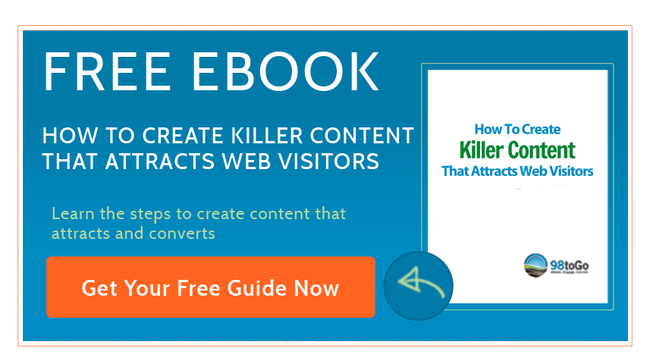
To run a successful inbound marketing campaign, it helps to know the basics. Although the look of a campaign can vary widely, the essentials of a great (and successful) campaign remain the same.
In this post I am going to give you a rundown of the components that make up a solid inbound marketing campaign.
I’ll start by talking about strategy and planning, making sure that your campaigns are off on the right foot.
Then I’ll move into the different content elements that are needed to capture and convert visitors. After that I’ll talk about ways to bring more visibility to your campaign. And I’ll wrap up by discussing the importance of measuring and assessing your campaign’s performance.
By the end of this post you’ll know more about what makes up a solid inbound marketing campaign so that you can design and implement an effective campaign for your organization.
Let’s get started!
Planning and Strategizing
It goes without saying that a solid campaign starts with intentional planning. Before you start writing blog articles, crafting offers or hitting social media, you will want to spend some time creating your plan of attack.
Buyer persona
Your buyer persona is where it all begins. The work you do here will set the stage for the rest of your campaign.
You want to know very specifically: who you are targeting, where they hang out online, what challenges and problems they wish to solve, what they need help with, what you need to say to engage them, the types of content that they turn to most, and more.
This HubSpot Buyer Persona Template is a great place to start if you need to work on your buyer personas.
Don’t skip this step because the work you put in here will influence everything down the line.
Campaign theme
Next, create a theme for your inbound marketing campaign. This theme needs to be relevant and interesting enough to your buyer persona for them to pay attention.
Your theme might relate to a core problem your buyer is looking to solve, or a recurring challenge that you can help them out with. Or it might relate to something timely and relevant in your industry, or perhaps something specific to your organization.
No matter how you select your theme, each piece of content within your campaign will support and relate back to this theme.
SMART goals
Goal setting is a critical piece of your campaign strategy, and S.M.A.R.T. goals are what you’re aiming for.
Along with goals you want to include your expected results. Here you’re beginning with the end in mindand setting the intention for your campaign.
After planning, comes creation.
Content Offers
This is where you start building. In this stage of your inbound marketing campaign you are designing and creating the assets that are going to get people into your sales funnel.
Premium offers
Your premium offer is the nucleus of your campaign. This is how you will be generating leads for your lead nurturing campaigns and sales teams.
An offer can take many forms: from an ebook or whitepaper, to a webinar or how-to-video, to a software demo or product information. The format that is right for you is the one that your buyer persona will engage with.
Now, in order to get your offers you’ll most likely require that your visitors “pay” for the content, in the form of their contact information. That currency is valuable to your visitors, so you need to make sure your offer is compelling and valuable to them.
Premium offers will typically fall into one of three categories:
- Top-of-the-funnel offers: these are for people doing research on a problem and looking for general information. People at this stage are most likely not yet interested in hearing your sales messages, so save that for later stages.
- Middle-of-the-funnel offers: these are for people who are building a list of options to solve their problem. Your customer is doing some comparison shopping now, pitting you versus a competitor versus an alternative.
- Bottom-of-the-funnel offers: these are for people who are ready to engage in a sales conversation with you. They have done their homework and now they want to see what your specific solution has to offer.
Once you have your premium offers, you now want to make them visible and accessible. That’s where call-to-action buttons come in.
Call-to-action
Call-to-action buttons are how you get people to take a specific action on your website. Also known as CTA’s, they will be placed on prominent pages of your website: homepage, service pages, blog page, within blog posts, and wherever else you wish to capture leads.
You will need to have engaging CTA’s with enticing language in order to get your website visitors to act.
No longer will “Contact Us” cut it, website visitors are too desensitized by marketing messages to be moved by an impersonal call to action.
Instead, refer back to your buyer persona and think about the language that your audience will respond to. It’s recommended to A/B test different types of CTA’s so that you can use data to tell you which ones are most effective.
If you’re looking for ways to create and use CTA’s effectively, this ebook will show you how to create killer CTA’s, and this blog article will help you design CTA’s without a design background.
Clicking on a CTA will direct your visitor to a landing page, and that’s where we’re going next.
Landing page
The landing page is where your website visitor will sign up to receive your offer. This is where you capture their information (where they “pay” you for the content), and where your visitor becomes a lead.
You will want to create different landing pages for your different campaigns. Each landing page should relate specifically to the offer that it is promoting.
Here’s a landing page checklist that you can use to make sure you’re pages are most effective.
In order to capture a lead on a landing page you will want an effective form.
Form
Your form serves two big purposes: learning about your potential customers and capturing leads.
You will want to absolutely ask for name and email address in your form, however you can also dig deeper and collect more valuable information that will be used in later parts of your campaign. However, the more fields you have on your form, the higher the friction to take action. So be sure to test different form lengths until you find the optimal balance for you.
Now that we’ve covered what is happening on your website to entice visitors into becoming leads, let’s talk about how you will attract visitors in the first place.
Attraction and Visibility
Have you heard of the phrase “market your marketing”? If not, get used to it, because these days if you’re not spending at least as much time marketing your content as you spent creating it, you can expect lackluster results.
It’s here where you begin to attract eyeballs to your website and your content.
Blogging
Blogging is a central part of your inbound marketing campaign. You will use blog posts to attract visitors to your website and to indirectly promote your offers.
The current blogging trends indicate that longer blogs are more effective, longer being around 1500 words or so. So when developing your blog posts keep this number in mind.
But don’t dwell on it.
Your posts need to first and foremost be valuable to your reader and worth their time. If you fail at that part it really doesn’t matter how long they are -- people won’t find them.
Refer back to your buyer persona to develop ideas for your posts around pain points and challenges your audience is having (but make sure they relate to your central campaign theme).
You can use these four templates to help create your different types of blog posts.
Content Creation
Along with blog posts, you’ll want to develop other forms of high quality content for your audience to consume. This is because different mediums are optimal for different content types. Example: an infographic is great for visually communicating data points or sequences, where a blog post is great for teaching heavy concepts or storytelling.
Some forms of content include: podcasts, webinars, infographics, videos, and interactive quizzes.
Social Media Distribution
This is where your content (blogging and otherwise) begins to get in front of eyeballs. Use your organization’s current social media channels to spread and promote your content.
Join LInkedIn groups in your niche and start conversations there around the topics you’re writing about (that’s also a great place to get ideas and find content collaborators!).
Remember, you must “market your marketing”, and marketing to your social media media following can be an effective place to begin.
Content Publication
This piece is another way to get your valuable content in front of new eyeballs who might not have seen it otherwise.
Present your content to websites, LinkedIn groups, and online communities where your prospects are hanging out. Again, if you were thorough in your buyer persona work then you’ll know where your prospects are spending their time online. You want to get your content in those places. This will drive traffic, leads and visibility to your website.
Paid Promotion
Sometimes it’s a great idea to incorporate a paid promotion campaign to your inbound marketing efforts.
By promoting an offer in very specific areas (like on LinkedIn), you can drive targeted prospects to your landing pages and into your funnel.
Here’s a fantastic article on how to combine earned and paid promotion to hit your goals.
So at this point you’ve got the traffic, you’ve got the leads, but you’re noticing that not every lead is ready for a sales conversation.
That’s where lead nurturing comes into play.
Lead Nurturing
Lead nurturing using email automation is an effective way to turn a lukewarm prospect into a hot, sales ready prospect.
Not every lead that you will capture in your forms is ready to talk to your sales reps. Many of them are simply seeking more information to help them solve their problem. If you hit them with a sales message at this point you’re likely to turn them off from your brand and solution. And that’s the opposite of what you want.
Instead, use lead nurturing to warm these interested leads into sales ready leads.
A lead nurturing campaign can look like a series of emails that answers frequently asked questions (before your prospect comes to you with them); or it could look like emails that provide your prospect with more information about the problem they are looking to solve (cementing you as a trusted authority in this space).
It all depends.
The idea with lead nurturing is that you want to deliver the right content to your prospects at the right time, depending on where they are at in the buyer’s journey.
Measuring and Improving
The final part of your inbound campaign is going to be assessment. You want to make sure that you’re measuring your progress at each step, and improving along the way.
This is where the SMART goals that you prepared at the beginning come back into play. At this step you’ll be able to see whether you hit your goals or not. And where you can improve.
It’s important to analyze your results throughout and at the end of your campaign. Knowing what was effective and what was not will help you as you design and execute your next inbound marketing campaigns.
Conclusion
Developing a solid inbound marketing campaign is both an art and science. The art comes in as you’re learning about your buyers, crafting your messaging, and writing your content to speak to your audience.
The science is knowing what to do, following the steps to building an inbound campaign, and using data to inform and influence your decision making throughout the process.
Of course not all inbound marketing campaigns are alike, even ones targeting the same buyer persona.
Some campaigns may rely on greater or fewer of the elements above, but a well rounded campaign takes advantage of all of the steps, methods and tools to success.
This article originally appeared on the 98toGo blog. 98toGo is a HubSpot Partner located in Atlanta, GA.


